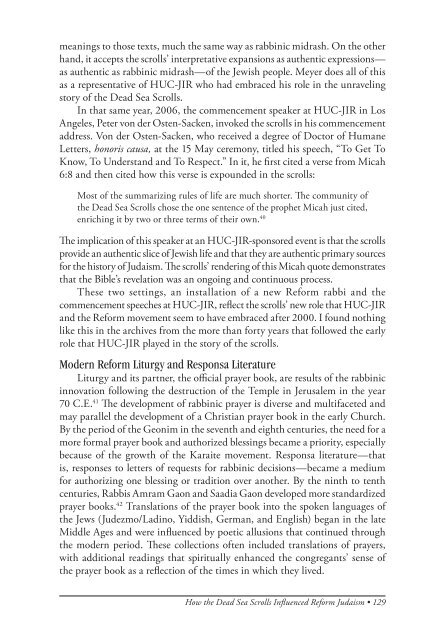The American Jewish Archives Journal, Volume LXI 2009, Number 1
The American Jewish Archives Journal, Volume LXI 2009, Number 1
The American Jewish Archives Journal, Volume LXI 2009, Number 1
You also want an ePaper? Increase the reach of your titles
YUMPU automatically turns print PDFs into web optimized ePapers that Google loves.
meanings to those texts, much the same way as rabbinic midrash. On the other<br />
hand, it accepts the scrolls’ interpretative expansions as authentic expressions—<br />
as authentic as rabbinic midrash—of the <strong>Jewish</strong> people. Meyer does all of this<br />
as a representative of HUC-JIR who had embraced his role in the unraveling<br />
story of the Dead Sea Scrolls.<br />
In that same year, 2006, the commencement speaker at HUC-JIR in Los<br />
Angeles, Peter von der Osten-Sacken, invoked the scrolls in his commencement<br />
address. Von der Osten-Sacken, who received a degree of Doctor of Humane<br />
Letters, honoris causa, at the 15 May ceremony, titled his speech, “To Get To<br />
Know, To Understand and To Respect.” In it, he first cited a verse from Micah<br />
6:8 and then cited how this verse is expounded in the scrolls:<br />
Most of the summarizing rules of life are much shorter. <strong>The</strong> community of<br />
the Dead Sea Scrolls chose the one sentence of the prophet Micah just cited,<br />
enriching it by two or three terms of their own. 40<br />
<strong>The</strong> implication of this speaker at an HUC-JIR-sponsored event is that the scrolls<br />
provide an authentic slice of <strong>Jewish</strong> life and that they are authentic primary sources<br />
for the history of Judaism. <strong>The</strong> scrolls’ rendering of this Micah quote demonstrates<br />
that the Bible’s revelation was an ongoing and continuous process.<br />
<strong>The</strong>se two settings, an installation of a new Reform rabbi and the<br />
commencement speeches at HUC-JIR, reflect the scrolls’ new role that HUC-JIR<br />
and the Reform movement seem to have embraced after 2000. I found nothing<br />
like this in the archives from the more than forty years that followed the early<br />
role that HUC-JIR played in the story of the scrolls.<br />
Modern Reform Liturgy and Responsa Literature<br />
Liturgy and its partner, the official prayer book, are results of the rabbinic<br />
innovation following the destruction of the Temple in Jerusalem in the year<br />
70 C.E. 41 <strong>The</strong> development of rabbinic prayer is diverse and multifaceted and<br />
may parallel the development of a Christian prayer book in the early Church.<br />
By the period of the Geonim in the seventh and eighth centuries, the need for a<br />
more formal prayer book and authorized blessings became a priority, especially<br />
because of the growth of the Karaite movement. Responsa literature—that<br />
is, responses to letters of requests for rabbinic decisions—became a medium<br />
for authorizing one blessing or tradition over another. By the ninth to tenth<br />
centuries, Rabbis Amram Gaon and Saadia Gaon developed more standardized<br />
prayer books. 42 Translations of the prayer book into the spoken languages of<br />
the Jews (Judezmo/Ladino, Yiddish, German, and English) began in the late<br />
Middle Ages and were influenced by poetic allusions that continued through<br />
the modern period. <strong>The</strong>se collections often included translations of prayers,<br />
with additional readings that spiritually enhanced the congregants’ sense of<br />
the prayer book as a reflection of the times in which they lived.<br />
How the Dead Sea Scrolls Influenced Reform Judaism • 129

















